Speech Risks to the Outlook

Guy Debelle[*]
Deputy Governor
Keynote Address at the 14th Annual Risk Australia Conference
Sydney –
- Audio 14.6MB
- Q&A Transcript
- Download 296KB
Today I am going to talk about some of the key risks around the outlook for the Australian economy. I will draw on the material published last week in the August Statement on Monetary Policy. On the global side, I will discuss some of the implications of the trade and technology disputes between the US and China. On the domestic side, the key risk for some time has been the outlook for consumption. I will highlight some of the main uncertainties that are likely to affect that outlook. Beyond the near-term risks for the economy, climate poses a material risk for the economy and financial markets over a longer horizon. Finally, given the audience, I will remind you of an actuality, not a risk, that you need to be prepared for; namely the cessation of LIBOR, the key interest rate benchmark in financial markets.
Trade and Technology Dispute
The trade dispute between the US and China has been with us in its current form for almost two years now. The direct effect of the tariffs that have been imposed to date on global growth has not been all that large, though the impact on particular businesses has been significant. Rather, the larger impact has been the uncertainty generated by the dispute. That uncertainty takes two forms: uncertainty about the size and incidence of the tariffs and uncertainty about how, and even if, the technology dispute will be resolved. On the tariff side, the prospect of a 25 per cent tariff is a first-order consideration in determining whether to invest in a new factory or new machinery and where to locate that investment.
It is plausible that the effect of the technology dispute will be larger than that of the tariffs. The technology dispute raises the possibility that any business involved in the technology production chain will have to choose between East and West rather than selling into a global market.
The uncertainty as to how the dispute will play out on both the trade and technology fronts means businesses are waiting to see how the uncertainty resolves rather than invest. It is too risky to commit to a multi-year project or buy a large piece of plant if the economics of the decision can get completely undermined by a policy decision.
The effect of that decision to wait rather than invest is clear in surveys of manufacturing businesses right round the world, which have fallen to low levels over the course of the past twelve months as the dispute has intensified (Graph 1). It is particularly apparent in east Asia, most obviously South Korea, as well as places like Germany. Both of these countries are heavily integrated in the global supply chain, and produce a large amount of investment goods. However, the impact is not universally negative. Some economies have actually recorded increases in investment. Vietnam, in particular, is close to full capacity as businesses relocate operations there to try to avoid the direct effect of the tariffs.
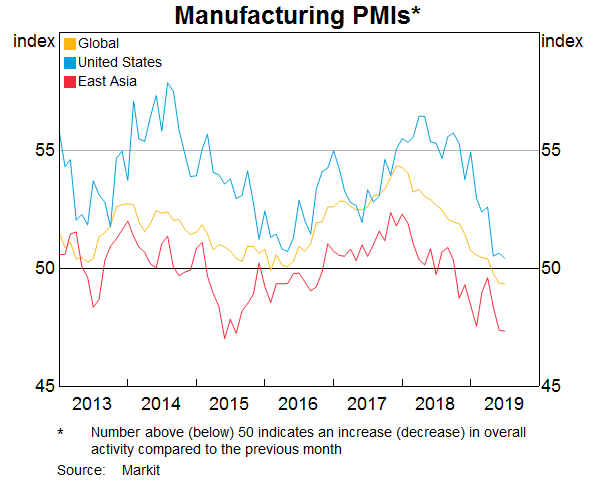
Investment in manufacturing sectors around the world is weak and is dragging on growth. At the same time, the domestic side of a number of economies, which is insulated from the trade dispute, has been resilient to date. Reflecting this, employment growth has been strong and unemployment rates are at multi-decade lows in the US, Japan, Germany and the UK. Notwithstanding the increased uncertainties around the outlook, businesses have been continuing to employ workers at a solid pace. In part, this is because it is generally easier and less costly for businesses to adjust the size of their workforce than it is to adjust their capital stock. In turn, both are much less expensive and easier to adjust than the decision to build a whole new factory.
But this short-term adjustment can only go on for so long. In the end, the decision to build or not build that new factory needs to be taken. The longer businesses hold off, the weaker demand will be, which will further confirm the decision to wait. That runs the risk of a self-fulfilling downturn. If, on the other hand, domestic demand remains resilient, there could be enough demand that businesses decide an investment will be profitable regardless of the trade uncertainty.
Another material outcome of the current dispute, which would have a large and long-lasting impact, is the threat it poses to the system of rules-based trade that has prevailed for many years. Despite some flaws, that system has provided a high degree of certainty around the operating environment. The China–US dispute casts serious doubt on that. We can also see that manifest in the US–Europe trade issues, as well as those between South Korea and Japan. Trade is being used as the bargaining tool of choice, including for issues that don't have much to do with trade.
How is the trade dispute affecting the Australian economy? Australia is not very involved in the global supply chain, particularly for technology. We consume the end product but we don't provide much of the inputs along the way. We export resources not microchips. While the Australian economy is often regarded as a proxy for China, the primary exposure of the Australian economy is to the Chinese domestic economy, not the Chinese external sector. The external sector has been the part of the Chinese economy most affected by the trade dispute. As the external sector in China has come under pressure from the trade dispute and the Chinese economy has slowed, the Chinese policymakers have responded with stimulus to the domestic economy. So far, they have been relying more on fiscal policy than monetary policy. Our assessment is that the degree of overall fiscal stimulus in China is probably about on par with that in 2015, but still noticeably less than the very large stimulus implemented in 2009 in the aftermath of the Global Financial Crisis.
The stimulus has been directed to the parts of the Chinese economy that are steel intensive, most notably infrastructure. This has boosted demand for coal and iron ore. In turn, the price of iron ore, in particular, rose by much more than expected, receiving a further significant boost from reduced supply in Brazil in the aftermath of the tailings dam collapse and weather-related supply disruptions in Australia. As a result, the terms of trade in Australia are at their highest level since 2013, and more than 10 per cent higher than we (and others) thought would be the case (Graph 2).
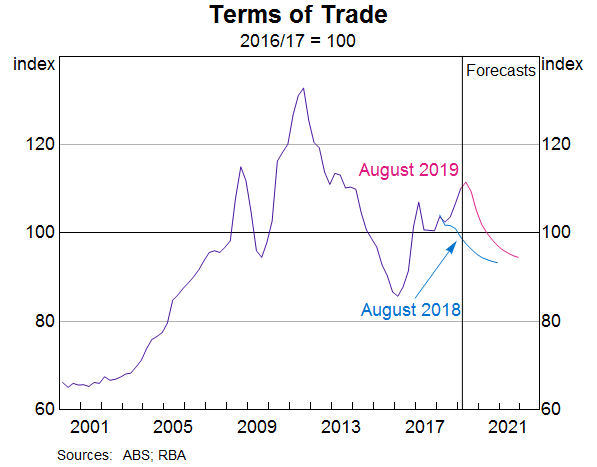
How does that rise in the terms of trade feed through the economy? It is a significant boost to national income, particularly given it has occurred alongside a depreciation of the Australian dollar. However, it is often difficult to pin down the channels through which a rise in the terms of trade propagates through the economy. What is clear is that we are not going to get a repeat of the resources boom that occurred when iron ore prices were last at these levels. There is some increased investment in train to maintain the current levels of production but not to materially increase them. So we have seen the effect of the increased demand in China reflected in the price not in higher export volumes.
While a significant share (around three-quarters) of these profits from the high iron ore prices accrue to foreign shareholders, some flows to domestic households through direct and indirect share ownership. Public sector revenue will also receive a boost, mainly through higher tax receipts and mining royalties. It is unclear what the governments will do with this unexpected revenue.
Hence, the domestic stimulus in China to offset the trade dispute has contributed to a short-term boost to the Australian economy and significantly mitigated the impact of the trade disputes on us. How long this lasts will depend on the effectiveness and longevity of Chinese domestic stimulus. The iron ore price has fallen from its peaks and we expect the iron price to decline further from here, and with it the terms of trade. But over the past year, we, along with the market, have been significantly surprised on the upside (Graph 3).
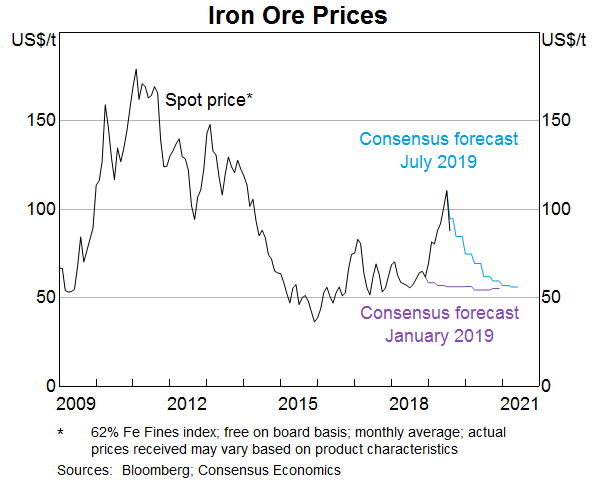
Australia also has significant exports to China in both tourism and education. To date, these have been broadly unaffected by the slowdown in the Chinese economy. But a further significant slowing in the Chinese economy and household incomes would clearly pose a risk.
To date, the Australian economy has been largely shielded from the effect of the trade disputes. But Australia has been a major beneficiary from the rules-based global trading system over many decades. The current threats to that are clearly a major risk for the Australian outlook over a longer horizon.
Consumption
Turning to the domestic economy, the primary risk for some time has been the outlook for consumption. The risks to consumption are always going to be important, because consumption is such a large share of the economy (around three-fifths).
Over the past few years, it has been challenging to assess both the current pace and outlook for consumption. In the first half of 2018, consumption had been recorded as growing at a solid pace, around 3 per cent. But the September quarter national accounts recorded both a notably slower pace of consumption growth in that quarter, and a downward revision to the recent history, so that growth was measured to be around half a percentage point slower than previously thought. This changed our assessment of the consumption outlook. The momentum was not as strong as previously thought, which was further confirmed with slow growth in consumption in the December and March quarters (Graph 4).
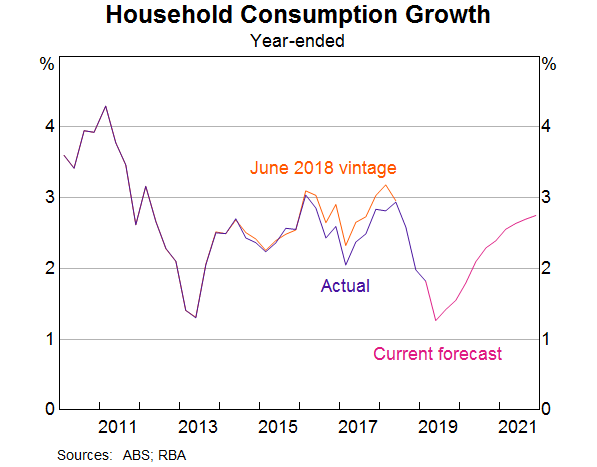
What has been weighing on consumption? A primary cause has been the slow pace of growth in household disposable income, that is, income after tax. Household income growth has been low for a number of years now. This is despite strong employment growth and clearly reflects the slow wages growth. As households have come to expect that this slow wages growth will persist, they have constrained their spending plans.
On top of that, despite the low income growth, household tax payments grew at a very fast pace: 10 per cent over 2018 (Graph 5).[1] This seems to have reflected increased compliance and lower tax deductions, as well as bracket creep. As a result, income left after tax was considerably less than we and, I suspect, households had expected. This contributed to a further slowdown in consumption spending.
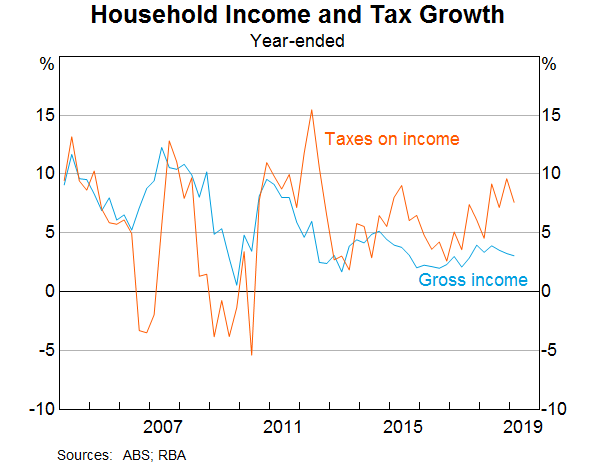
Overlaid on the slow growth in household income has been the effect of the decline in housing prices. Some part of that effect comes through a wealth effect: as housing prices fall, homeowners' wealth declines, which reduces their spending. Some part of the effect comes through the lower housing turnover that has accompanied the decline in housing prices. Housing turnover is around its lowest level in more than 20 years. When people move house, they spend more on things like household furniture.[2] The decline in housing prices has also been accompanied by a particularly large reduction in spending on cars.
Looking forward, there are a number of factors moving in different directions that affect the outlook for consumption. Income growth is picking up a little. We do not expect much of an increase in wages growth although employment growth is expected to be reasonable, though slower than recent history. But household disposable income growth is likely to be higher because of the direct effect of the tax offset payments to low and middle income households, and also because we don't expect that tax payments will continue to significantly outpace income growth. Low and middle income households are getting their tax refunds around about now. It is uncertain how much of that they will spend or save, or use to pay down their mortgage. Based on past experience, we are assuming they will spend around half of it. We will see how this plays out through our liaison and in the data in the coming months.
Households are also benefiting, in aggregate, from the effect of lower interest rates. While the income of households with deposits is lower, the household sector as a whole has around twice as much debt as deposits. Hence the cash flow boost from lower mortgage payments outweighs that of lower deposit rates. Again, there is uncertainty about how much of that cash flow boost will be spent or saved, including in the form of paying down mortgages faster. If households use the additional cash flow to pay down their mortgages, it does bring closer the date that they will be more comfortable with their balance sheets and return to more regular spending habits.
A final factor affecting the consumption outlook is the dynamics in housing markets. There is evidence that the decline in housing prices has reached its end. If this is the case, the drag from declining wealth and turnover will dissipate. Housing market conditions may even start to support consumption growth again in the period ahead.
In conclusion, there are some near-term downside risks to the consumption outlook, including from a softer labour market. But further out, the risks to the outlook are more evenly balanced.
Looking at the domestic outlook more broadly, we are expecting the GDP growth outcomes to strengthen after a run of disappointing numbers. This outlook is supported by a number of developments including: lower interest rates, the recent tax cuts, a depreciation of the Australian dollar, a brighter outlook for investment in the resources sector, some stabilisation of the housing market and ongoing high levels of investment in infrastructure. Determining with precision the combined effect of these developments is difficult, but the overall risks appear to be more balanced.
Climate Risk
Having talked about two major near-term risk for the economic outlook, I would also remind you to take appropriate account of one risk that plays out over a longer horizon, namely climate risk. I talked about this in detail earlier in the year.[3] Given your roles as risk managers, it is important that you have a useful framework to assess this risk to your business.
Climate is a challenging risk to assess but an increasingly necessary one. Businesses need to take account of both the physical risks and the transition risks. Physical risk is about the direct impact of climate on your business and the assets that it holds. What will be the effect of climate change on the price of an asset my company owns, particularly if it is a long-lived asset such as, for example, a mortgage? Transition risk is about the potential effects to businesses as the country and the economy adjusts to the changes in the climate. This includes the adjustment to policy responses required to meet the Paris objectives.
As risk managers, you can bring your skills at calculating the expected future value of financial assets across a number of potential scenarios. In that sense, climate risk is not that different from other risks, though the challenge of translating uncertain future paths for the climate into paths for the economy and the prices of financial assets is harder than some of the other risks that you generally deal with. But it is a challenge that needs to be confronted.
I would emphasise the importance of disclosure, echoing the comments by Geoff Summerhayes of APRA and John Price of ASIC, as well as the information that ASIC released earlier this week.[4] You should all be aware of the recommendations of the recent report of the Task Force on Climate-related Financial Disclosures (TCFD) chaired by Michael Bloomberg. It is important not just to have disclosure for disclosures sake, but to have consistent and informative disclosure. Investors need to be able to take account of that information in making their decisions, and be able to compare that across companies and across financial assets. Risk management under uncertainty is always challenging, but the challenge can be reduced with better and consistent information both in terms of the data inputs and the consistency of the scenarios considered.
Interest Rate Benchmark Reform
The final issue I would like to talk about is quite different from the risks I've discussed so far. The end of LIBOR is not a risk. It's a certainty that the finance industry needs to be ready for.[5]
It has now been just over two years since Andrew Bailey announced that the FCA (the Financial Conduct Authority) would no longer use its powers to sustain LIBOR beyond 2021. Financial regulators around the world expect institutions using LIBOR to be ready to transition to more robust benchmarks. With strong support from the RBA and APRA, ASIC recently wrote to the CEOs of major Australian financial institutions to seek assurance that they are taking appropriate action.[6]
The transition from LIBOR to alternative risk-free rates (RFRs) is accelerating internationally. Usage of RFRs in derivatives markets is increasing, and they are being adopted in some cash products. There has also been good progress on developing more robust fall-back provisions in contracts referencing LIBOR. ISDA has completed consultations on the fall-back methodology for almost all of the LIBOR currencies (and some other IBORs including BBSW).[7] ISDA found strong support for using as the fall-back: the compounded RFR with an adjustment for the historical spread between the RFR and LIBOR. Once ISDA has finalised the fall-back provisions, regulators expect users of benchmarks to adopt them.
In Australia, we have taken a different path. The credit-based benchmark BBSW (the Bank Bill Swap Rate) has been strengthened and coexists alongside the cash rate, which is the risk-free rate for the Australian dollar. This has been possible since both BBSW and the cash rate are supported by underlying markets with enough transactions to calculate robust benchmarks.
We have been encouraging users of Australian dollar benchmarks to be choosing the benchmark that is most appropriate for their circumstances. Sometimes it makes sense to use a credit-based benchmark, such as BBSW, particularly when banks are issuing funding instruments. However, it often makes more sense to use a risk-free benchmark, such as when governments raise funding. There has been progress on this in recent months, with the South Australian Government Financing Authority issuing the first FRN referencing the cash rate.
Nevertheless, the lesson from LIBOR is that no benchmarks should be taken for granted. So while BBSW remains robust, it is prudent to have robust fallbacks in your contracts in case it were ever to cease. This is why we have been working with ISDA to strengthen the contractual fallbacks for BBSW too. Once ISDA has finalised the fall-back provisions, we expect all users of BBSW to adopt them where possible. The RBA will be managing our own risks in this area by requiring new securities referencing BBSW to have robust fall-back provisions in order to be eligible in the RBA's market operations.
Conclusion
To conclude, I have highlighted two near-term risks to the economic outlook, one global, one domestic. I have also raised the longer-term risk of climate. None of these risks are easy to assess, but nor can they be ignored. I have also highlighted the issue of benchmark reform that is not a risk but an actuality, which absolutely needs attention right now.
Endnotes
Thanks to Mark Chambers, Ellis Connolly and Tom Rosewall for helpful input. [*]
Ellis L (2019), ‘What's Up (and Down) With Households?’ Address to Housing Industry Association March Industry Outlook Breakfast, Sydney, 26 March. [1]
See May D, G Nodari, and D Rees (2019), ‘Wealth and Consumption’, RBA Bulletin, March. Available at <https://www.rba.gov.au/publications/bulletin/2019/mar/wealth-and-consumption.html>. [2]
Debelle G (2019), ‘Climate Change and the Economy’, Address at the Centre for Policy Development, Public Forum, Sydney, 12 March. [3]
Price J (2018), ‘Climate Change’, Keynote address at the Centre for Policy Development: Financing a Sustainable Economy, Sydney, 18 June. Available at <https://asic.gov.au/about-asic/news-centre/speeches/climate-change/>. Summerhayes G (2017), ‘Australia's new horizon: Climate change challenges and prudential risk’. Available at <https://www.apra.gov.au/media-centre/speeches/australias-new-horizon-climate-change-challenges-and-prudential-risk>. See also <https://asic.gov.au/about-asic/news-centre/find-a-media-release/2019-releases/19-208mr-asic-updates-guidance-on-climate-change-related-disclosure/> [4]
I have talked about this issue previously: Debelle G (2019), ‘Progress on Benchmark Reform’, Keynote at ISDA's 34th Annual General Meeting, Hong Kong, 11 April; Debelle G (2018), ‘Interest Rate Benchmark Reform’ Speech at ISDA Forum, Hong Kong, 15 May; Debelle G (2017), ‘Interest Rate Benchmarks’, Speech at FINSIA Signature Event: The Regulators, Sydney, 8 September; Debelle G (2016), ‘Interest Rate Benchmarks’, Speech at KangaNews Debt Capital Markets Summit 2016, Sydney 22 February; Debelle G (2015), ‘Benchmarks’, Speech at Bloomberg Summit, Sydney, 18 November. [5]
See RBA, APRA, ASIC (2019), ‘Regulators Urge Financial Institutions to Plan for LIBOR Transition, Joint Media Release, 9 May. Available at <https://www.rba.gov.au/media-releases/2019/mr-19-12.html>. [6]
See ISDA (2018), ‘ISDA Publishes Final Results of Benchmark Fallbacks Consultation’, Press Release, 20 December. Available at <https://www.isda.org/2018/12/20/isda-publishes-final-results-of-benchmark-fallback-consultation/> and ISDA (2019), ‘ISDA Publishes Preliminary Results of Supplemental Benchmark Fallbacks Consultation’, Press Release, 30 July. Available at <https://www.isda.org/2019/07/30/isda-publishes-preliminary-results-of-supplemental-benchmark-fallbacks-consultation/>. [7]